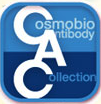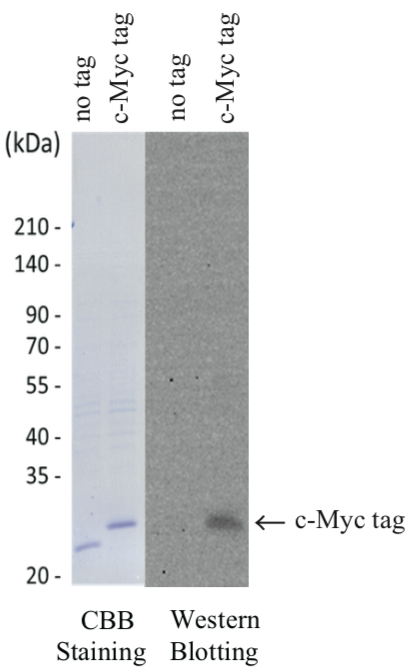 CAC Antibody Collection
CAC Antibody Collection
The antibodies on this page are part of Cosmo Bio's exclusive CAC Collection. For many many thousands of other antibodies from many different makers, use our Search the Store function and our Explore Products drop down menu.
Epitope tags
The production of recombinant proteins in a highly purified and well-characterized form has become a major task for the protein chemist working in the pharmaceutical industry. In recent years, several epitope peptides and proteins have been developed to over-produce recombinant proteins. These affinity-tag systems share the following features: (a) one-step adsorption purification; (b) a minimal effect on tertiary structure and biological activity; (c) easy and specific removal to produce the native protein; (d) simple and accurate assay of the recombinant protein during purification; (e) applicability to a number of different proteins. Nevertheless, each affinity tag is purified under its specific buffer conditions, which could affect the protein of interest. Thus, several different strategies have been developed to produce recombinant proteins on a large scale. One approach is to use a very small peptide tag that should not interfere with the fused protein. The most commonly used small peptide tags are poly-Arg-, FLAG-, poly-His-, c-myc-, S-, and Strep II-tag. For some applications, small tags may not need to be removed. The tags are not as immunogenic as large tags and can often be used directly as an antigen in antibody production. The effect on tertiary structure and biological activity of fusion proteins with small tags depends on the location and on the amino acid composition of the tag (Bucher et al. 2002). Another approach is to use large peptides or proteins as the fusion partner. The use of a large partner can increase the solubility of the target protein. The disadvantage is that the tag must be removed for several applications e.g. crystallization or antibody production. [from: Terpe, K. Appl Microbiol Biotechnol (2003) 60: 523. https://doi.org/10.1007/s00253-002-1158-6]| Product name (click for order info) | Cat No (click for datasheet) |
Host | Species specificity |
| Anti Enhanced Green Fluorescent Protein (EGFP) pAb (Rabbit, Antiserum) | CAC-SU-IZ-P01 | RAB | Aequorea victoria |
| Anti Myc Proto-Oncogene Protein (c-Myc) mAb (Clone 9E10) | CAC-XIM-MA001 | MS | HU |
| Anti Auxin Inducible Degron (AID/IAA17) Tag mAb | CAC-APC004AM-T | MS | - |
| Product name | Anti Enhanced Green Fluorescent Protein (EGFP) pAb (Rabbit, Antiserum) |
| Cat No | CAC-SU-IZ-P01 |
| Description | Anti EGFP antibody is a rabbit polyclonal antibody obtained from rabbit immunization with purified E. coli-derived recombinant EGFP. This antibody has been tested and confirmed for use in immunoblotting against enhanced GFP. |
| Host | Rabbit |
| Species specificity | Aequorea victoria |
| Product name | Anti Myc Proto-Oncogene Protein (c-Myc) mAb (Clone 9E10) |
| Cat No | CAC-XIM-MA001 |
| Description | c-Myc is a very potent oncogene upregulated in various types of cancer. c-Myc, through its role as a transcription factor, alters the expression of hundreds of target genes, often oncogenes or tumor suppressors. Clone 9E10 recognizes recombinant proteins that incorporate the c-Myc epitope tag and detects human c-Myc proteins and peptides in random coil rather than alpha-helix structures. References: 1) Mateos-Gomez et al. 2015. Nature. 518(7538):254-7. PMID: 25642960. (WB) 2) Zhang et al. 2014. Genes Dev. 28(8):829-34. PMID: 24736842. (ChIP) 3) Zhou et al. 2012. J Cell Biol. 196(2):203-11. PMID: 22270916. (IP, WB) 4) Mendes et al. 2010. J Biol Chem. 285(50):39117-26. PMID: 20937822. (IP, WB) 5) Royds et al. 1992. J Pathol. 166(3):225-33. PMID: 1381423. (IHC) 6) Spandidos et al. 1987. Anticancer Res. 7(6):1299-304. PMID: 3327455. (IHC) 7) Kari et al. 1986. J Virol. 60(2):345-52. PMID: 3021969. (IP) 8) Evan et al. 1985. Mol Cell Biol. 5(12):3610-6. PMID: 3915782. (WB) |
| Host | Mouse |
| Species specificity | HU |
| Figure 1 |  |
| Anti c-Myc detection of c-Myc tag: Based on CBB staining result, c-Myc tagged fluorescent protein migrated at a higher molecular weight compared to control fluorescent protein (no tag). Based on the Immunoblot result, c-Myc tagged fluorescent protein was detected, though no band was detected with no tag. |
|
| Product name | Anti Auxin Inducible Degron (AID/IAA17) Tag mAb |
| Cat No | CAC-APC004AM-T |
| Description | Detection of intracellular AID plasmid (pAID1.1-N Vector, pAID1.1-C Vector or Luc-AID NLS plasmid) expression is very critical for scientists who integrate them into cells. Anti-AID protein tag antibody (IAA17) provides an excellent means for monitoring gene expression and protein localization in living cells. Monoclonal anti-AID tag (IAA17) antibody can detect AID tag (IAA17) in immunoblot experiments. References: Nature Methods (2009) 6:917-923 |
| Host | MS |
| Species specificity | - |
